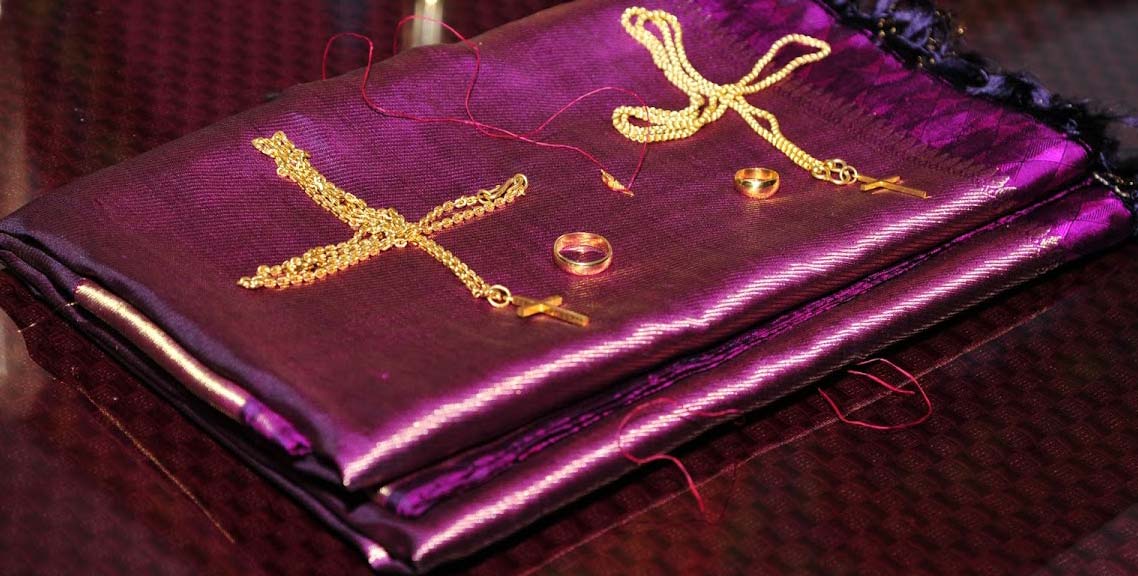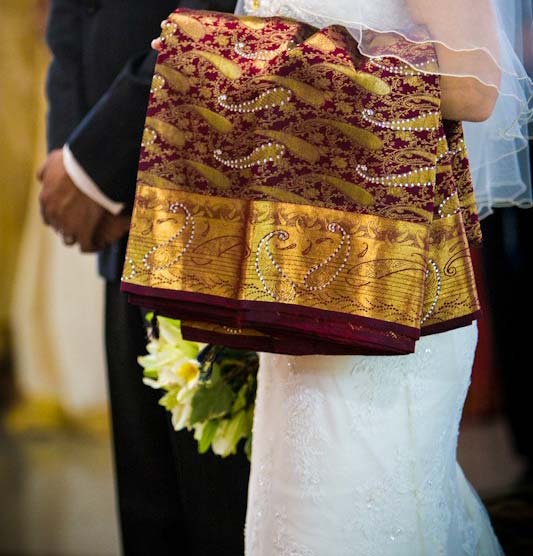
Whenever we think of Christian weddings, the first image that pops up, of course, is the beautiful, regal wedding gowns. However, soon after, during the reception, comes the second best of the Christian wedding wardrobe, namely, the Manthrakodi. Manthrakodi or the ‘blessed cloth’, however; has more to it than being a beautiful addition to the wedding wardrobe. Manthrakodi is culturally, one of the integral parts of Syro-Malabar Christian weddings.
Manthrakodi is the first gift of the groom to the bride soon after the Minnukett. The minnu or thali, as is referred to in Indian customs, is a pendant strung on a chain made by intertwining 21 threads taken from the Manthrakodi in 7 sets using three each. These 7 sets stand for the parents of the groom and bride, the groom, the bride and the Church or the 7 gifts of the Holy Spirit. This simple chain of threads is worn for three days and then replaced with a permanent gold chain. The Minnu/pendant with a cross, is the symbol of Christianity, on a gold medallion shaped like a heart. The heart symbolises the concept of love, and the cross reflects the relationship between a husband and wife, which signifies the relationship between Jesus and his bride – the Church.
The Manthrakodi is later worn for the wedding reception, and then in future rarely on important occasions until on the death of the bride. During the funeral, the woman is wrapped in her Manthrakodi or she is draped in it. This is symbolic of eternal love that transcends even death.

Usually rich silk with silver and gold embroidery, the Manthrakodi is placed over the bride’s head by the priest as prayers are recited after Minnukett. This practice implies a lot of things. Firstly, it is symbolic of how all the love, protection, and care of the groom now rests with the bride. Also, it means that the responsibility of the bride now rests with the groom. During this ritual, the female relative or sister who usually stands right behind the bride during the initial ceremony is replaced by one amongst the closest female relatives of the groom as symbolic of a family shift and induction of the bride into the groom’s family.
This practice is also symbolic of Rebekah. Rebekah, who, on arriving from her marital home to Abraham’s to marry his son Isaac on camel back, covered herself in a veil when she saw Isaac. This was an act of humility, chastity and devotion to her lifelong partner united in marriage by God.
The Manthrakodi is usually picked by the bride and her family though gifted by the groom. Often it is picked by the two families together as is the case in most weddings now. Though most prefer red or shades of it due to the association of red with vigour, femininity and fertility, Manthrakodi can be chosen in other colours too.
What better way to reminiscence your day than six yards of prettiness!






















